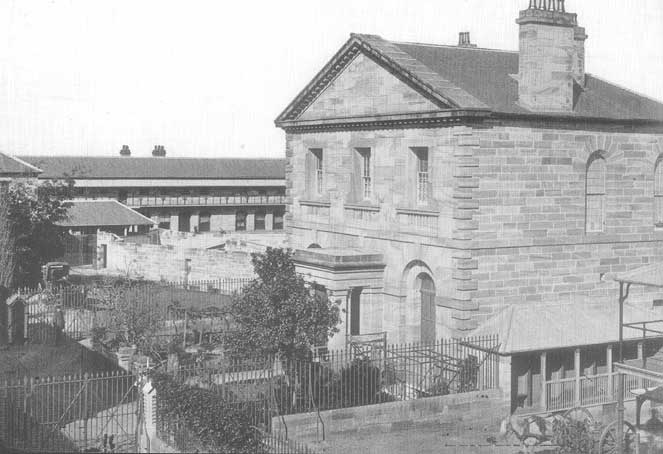
Parramatta Gaol. Source: www.parragirls.org.au
Continuing the focus on this year’s Sydney Festival, there’s an array of music, dance, circus and theatre showing outside the CBD, including at Parramatta Gaol. I spoke on behalf of the Dictionary of Sydney on 2SER about the history of Australia’s oldest and most intact gaol…
The first gaol in Parramatta was built in 1796 near the southern part of Prince Alfred Park and was designed by Governor John Hunter to incarcerate robbers. It was made of double log and thatch, so as you can imagine being highly flammable it didn’t last long and was torched by arsonists in December 1799. Unfortunately the inmates were ‘shockingly scorched’.
In August 1802, construction began on a second gaol on the same site, this time using stone. Supervised by the Parramatta magistrate Reverend Samuel Marsden, who was nicknamed ‘the flogging parson’, the building was funded by a tax on alcohol and completed in 1804. On the top floor was a linen and woollen factory, where convict women worked in cramped conditions. Floggings were carried out within the confines of the gaol yard, whereas executions were conducted outside for the public to witness. And of course, that age-old instrument of public humiliation, the stocks were placed at the entrance.
Over the next 30 years the gaol deteriorated and became overcrowded. Governor Richard Bourke petitioned the Colonial Office in London for a new gaol. The commanding royal engineer Captain George Barney designed it and construction commenced at a new site to the north of the town. Economic depression in 1842 momentarily halted construction, however a perimeter wall, governor’s house, and three two-storied wings had been completed, and it opened on 3 January 1842. Thomas Duke Allen was the first gaoler, and lasted 20 years along with his wife Martha, who was matron for the female inmates.
Extensions were added to the gaol in the late 1850s and 1880s so that by 1897, Parramatta Gaol was the second largest in the colony, with 364 men and eight women convicts. By June 1899, double cells were converted to single cells, the prisoners underwent physical drills, a sixth wing was added and even electricity was installed!
Between 1918 and 1922 it was closed briefly and used as a mental health facility. Originally Parramatta Gaol was designed to hold habitual criminals who could be occupied with productive tasks. It went back to this original purpose and by 1929, it had become the State’s leading manufacturing gaol producing boots, brushes, tinware, clothes and many other useful materials.
Changes were made again in the 1940s and the 1970s. Between 1997 and 1998 the Parramatta Correctional Centre, as it was renamed, closed. In 2004, after over 160 years in operation, the future of the facility was thrown into uncertainty when two inmates scaled the wall undetected and escaped.
During its last years of operation, it was classified as a medium-security short-term Remand Centre, Transient Centre and Metropolitan Periodic Detention Centre. As it closed in October 2011, it was Australia’s oldest serving correctional centre. Though the gaol has been empty for some time its buildings remain as a historical remnant of a penal philosophy from long ago, and it’s now, ironically perhaps, a stage for one of Sydney’s most popular cultural attractions – the Sydney Festival.
Listen to my Dictionary of Sydney segment at 2SER radio. For other interesting segments, see my Dictionary of Sydney project post and visit the Dictionary of Sydney blog.
